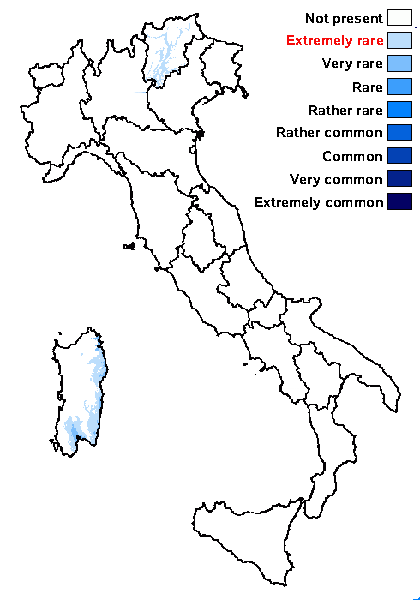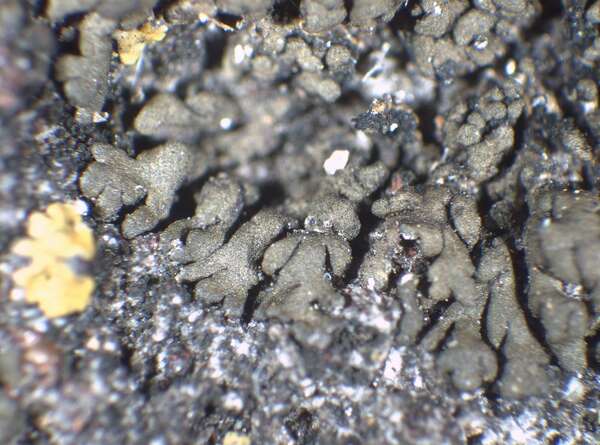Peltula placodizans (Zahlbr.) Wetmore
Ann. Missouri Bot. Gard., 57: 196, 1970. Basionym: Heppia placodizans Zahlbr. - Bull. Torrey Bot. Cl., 35: 299, 1908.
Synonyms: Endocarpiscum placodizans (Zahlbr.) Fink
Distribution: N - TAA. C - Sar.
Description: Thallus crustose-placodioid, areolate in center, lobed at margins. Central areoles rounded, flat or convex, 0.1-0.5 mm in diam., with blackish, laminal, capitate soralia bearing farinose soredia; marginal lobes simple to slightly branched, to 1.3 mm long, 0.2-0.5 mm wide, brownish to olive-green; lower surface paler than upper surface. Upper cortex not developed, but upper surface with a yellowish epinecral layer; medulla of loosely interwoven hyphae with globose cells and numerous air spaces; lower cortex poorly developed, paraplectenchymatous with globose cells. Apothecia very rare, 0.1-0.3 mm across, usually 1 per squamule, immersed, with a punctiform, yellowish brown to blackish brown disc, and a poorly evident thalline margin. Epithecium yellowish brown, K+ red-violet or K-; hymenium colourless, I+ wine-red. Asci >60-spored, clavate to obclavate, rostrate, the wall I+ orange, K/I+ blue. Ascospores 1-celled, globose to ellipsoid, (3-)4.5-8 x 3-5 µm. Pycnidia: immersed, cerebriform. Conidia fusiform, c. 3.5 x 1.5 µm. Photobiont cyanobacterial, chroococcoid. Spot tests: thallus and medulla K-, C-, KC-, P-, UV-. Chemistry: without lichen substances.Note: on steeply inclined seepage tracks of basic siliceous rocks, both in the Mediterranean belt and in warm-dry Alpine valleys.
Growth form: Crustose placodiomorph
Substrata: rocks
Photobiont: cyanobacteria, filamentous (e.g. Nostoc, Scytonema)
Reproductive strategy: mainly sexual
On otherwise dry surfaces with short periods of water seepage after rain
Commonnes-rarity: (info)
Alpine belt: absent
Subalpine belt: absent
Oromediterranean belt: absent
Montane belt: absent
Submediterranean belt: extremely rare
Padanian area: absent
Humid submediterranean belt: absent
Humid mediterranean belt: absent
Dry mediterranean belt: very rare

Predictive model
Herbarium samples
Growth form: Crustose placodiomorph
Substrata: rocks
Photobiont: cyanobacteria, filamentous (e.g. Nostoc, Scytonema)
Reproductive strategy: mainly sexual
On otherwise dry surfaces with short periods of water seepage after rain
Commonnes-rarity: (info)
Alpine belt: absent
Subalpine belt: absent
Oromediterranean belt: absent
Montane belt: absent
Submediterranean belt: extremely rare
Padanian area: absent
Humid submediterranean belt: absent
Humid mediterranean belt: absent
Dry mediterranean belt: very rare

Predictive model
| Herbarium samples |
 Index Fungorum
Index Fungorum
 GBIF
GBIF




